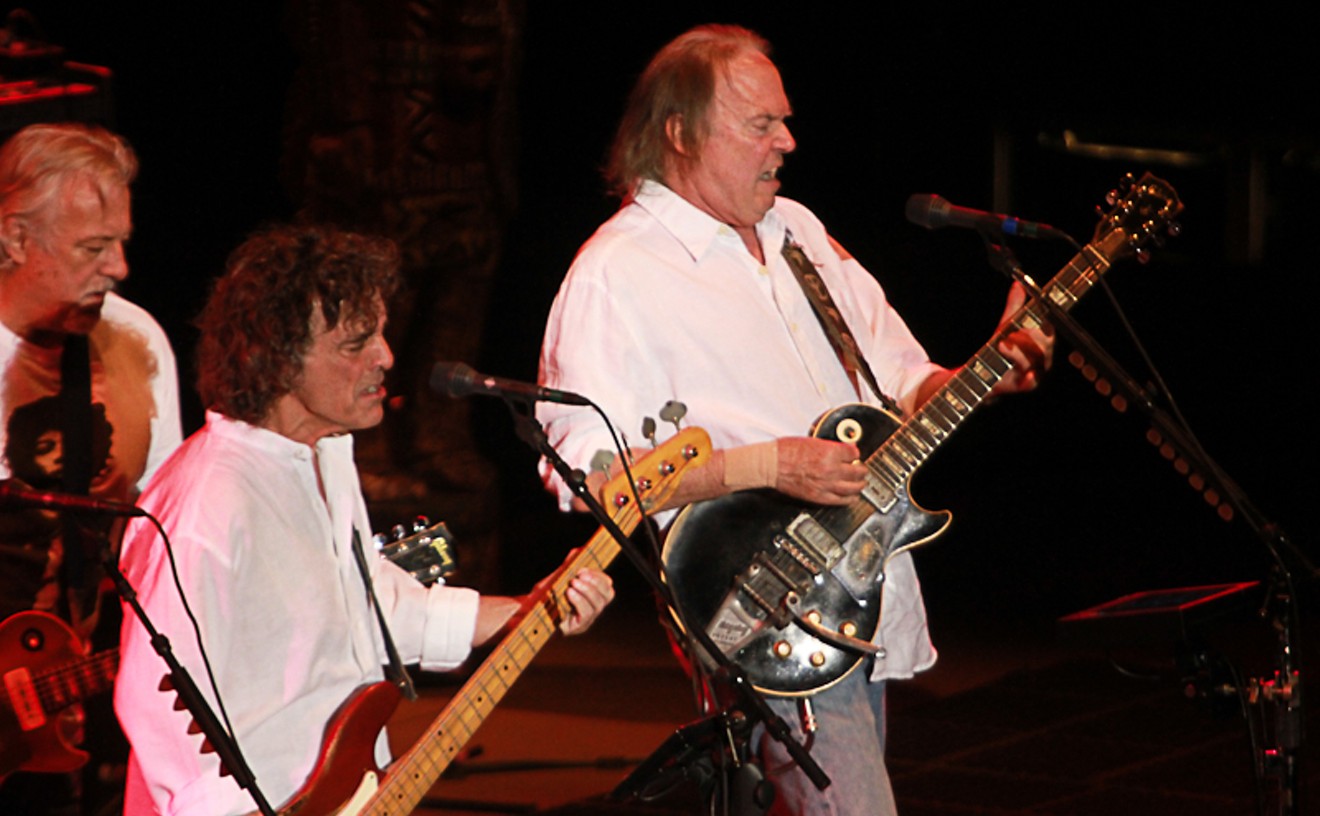"It's reflected in the cover -- that sense of when children draw, for that moment when they're drawing, it becomes real," Smith explains in a late-night phone call from his home in England. "And yet it's obviously not. But just for that very brief moment, there is a sense that this is all that matters. That's what I wanted the record to sound like."
To those bereft and introspective souls who've long worshiped the very eyeliner the Cure members slather on, Smith and his bandmates are the only group that matters. The jumpy bits of post-punk paranoia found on early recordings like Boys Don't Cry morphed into 1982's roaring Pornography; then the fizzy depresso-pop style adopted on 1985's The Head on the Door started to attract a wider audience. By 1989, the doggedly atmospheric album Disintegration spawned a number-two single in "Love Song." It was followed in 1992 by Wish, which debuted at number two on the Billboard album chart, on the strength of the carefree yowl "Friday I'm in Love." Despondent spirals, hopeless pining, love-filled ecstasy, dizzying euphoria -- the Cure understood every mood-swinging emotion and conveyed them all as no one else did.
The Cure veers between these extremes as well, although its recording process was different from that of any previous Cure album. Tracked live with very little mixing, "everything was done on a song-a-day basis," Smith reports. "There was no going back. You had one day to get the song; you had to nail the performance." Which is why the disc demands attention -- everything from the panicked cry of "I can't find myself," on the grinding "Lost," to the seductive, dusky riffs of "Alt.end" throbs with vitality.
What's more interesting is the way in which The Cure serves as a comprehensive sampler for the band's back catalogue. The fated lovers of "Never" part to music that resembles the dark catchiness of The Head on the Door and the sonic wistfulness of Disintegration ("Before Three"); Pornography's clawing gloom ("Us or Them") and the carefree optimism of Wild Mood Swings' "Mint Car" ("Taking Off") also appear.
"I thought, if we make a record and seriously called it The Cure, it has to include all the elements I like about the band -- as many as we can fit into one record," Smith says. "So I knew it was going to be a varied bunch of songs. If anything, I was trying to achieve some kind of a feeling, a weird mix of starting something as well as finishing it. The album references a lot of what we've done in the past. Maybe not sonically, but certainly melodically and lyrically, there's recurring themes.
"I just wanted to capture all of that feeling of doing something for the first time, really," Smith adds, "which sounds very strange after all these years. There was a genuine sense in the studio that without me even saying anything, that this should feel like the first and the last time that we ever do something like this."
Such doomsday rumblings aren't new for the Cure, who essentially broke up for a while in the 1980s and have been threatening to collapse again for years now -- most recently after 2003's Trilogy DVD, which was based on a 2002 Berlin concert where the band performed its three gloomiest discs (Pornography, Disintegration and 2000's Bloodflowers) in their entirety. Oddly enough, what brought the band back together this time was Ross Robinson, the producer largely responsible for Limp Bizkit and Korn.
"Entirely from a fan's perspective," says Smith, "he was saying that now is the time, that if you do really want to finish, you have to finish with something new. He felt the time was right, in a very pragmatic sort of way. He was going, 'Everyone's talking about you, and you're going to stop it; that doesn't make any sense.' He just kept chipping away at me, really. All it needed was for me to be nudged in the right direction.
"My plan was to finish with a grand flourish, with the Trilogy film, 25 years," Smith continues. "It is and was a great plan on paper, but I hadn't taken into account how I might feel about the whole thing. There was a part of me thinking, 'Well, why am I walking away from this? This is the best it's ever been!' I don't feel my age. I don't feel like I've been doing it for 25 years. I was giving myself an escape route if I needed it, and when I got to that point, I realized, with Ross's encouragement, that I didn't really need the escape route."
In a sense, Smith's rediscovery of his youthful vigor underscores the childlike facets of the Cure. The sparse simplicity of its debut disc Three Imaginary Boys resembles snotty nursery rhymes, while the group's constant experimentation with no worries about consequences (the children's-song-on-acid "The Caterpillar" and hit-or-miss forays into remix land) is reminiscent of a toddler's naive curiosity.
Most important, the Cure's uncensored honesty is the type that springs only from the mouths of babes. Whether the band was hazy with drugs (a bizarre B-side like "Mr. Pink Eyes") or uncertain about musical direction (its mid-to-late-1990s originals), the texture and content of the music reflected it -- for better and for worse. In fact, being an imperfect open book is the characteristic that makes the Cure so inviting and accessible.
"Finding someone on your own wavelength 'that, essentially, is what I've been doing for most of my adult life," Smith explains. "Wanting to communicate with other people who think and feel the same things.
"[Ross] said something really good one day," Smith concludes. "'Imagine how you're going to feel when you first get this record and you listen to it on your own. That's what you have to bear in mind.' The power of that, and when you've heard albums as you were growing up or even now, that you'll listen to a piece of music and you think, 'Oh, my God.' It's that feeling that's important, because without it, life is a much poorer experience."










